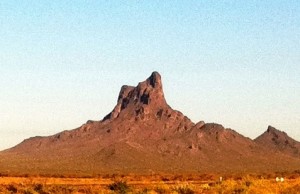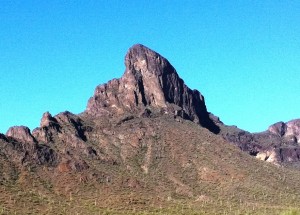It had been in my mind for some time. Picacho Peak is a fascinating and major focal point of the Arizona landscape, located perhaps 40 miles north of Tucson. I’ve wanted to explore both the peak and its surrounding area almost since my first return to Tucson last May.
Earlier this year Arizona celebrated the 150th anniversary of the only Civil War skirmish that occurred in Arizona — right there in Picacho Pass. The Union forces lost that particular encounter because of the disobedience of an overeager young lieutenant. They also suffered three fatalities in that fight.
The little bit of publicity I saw about this anniversary only heightened my interest in climbing the peak. So I set out one fine Friday with a friend to get it done.
Our very first picture was taken at about 7:30 am in the morning as we approached Picacho Peak from the south on Interstate 10. At that angle and distance one might begin to wonder, how the heck do we even begin to think that we can actually make the ascent? And if we look at the seemingly insatiable demands for energy, how might we do anything but dig for more coal or drill for more oil?
Almost directly east of the peak and from less than a mile away, we begin to see new possibilities that did not seem to have been there before. After a bit of parallel processing I began to think about Picacho Peak as a useful metaphor for meeting our energy needs – what we see and what we recognize very much depends on where we are standing at some moment in time, as well as what we see in different light and a from different focal point. . . . And if we simply (or not so simply) shift to a different spot and observe a given feature (maybe the energy conundrum) from another angle, from a different elevation, and even in other daylight, we might see entirely new aspects from what we had first imagined.
It turns out that the way up to the peak requires that we actually move to the backside of this very big outcrop of rock. It’s not for the faint of heart, but the way up is a both a manageable and satisfying result. In a similar way, if we look at energy not as a problem of inadequate supply, but one that is driven by enormous waste, we can begin to think of different and more cost-effective ways to ease the national concern.
As I’ve written about this before – Red and Blue – What is the Color of Energy? – it turns out that we waste about 86 percent of the energy that we throw at the economic problem. That means there is a much easier way to manage our energy needs. . . . We can dramatically reduce our waste. In the same way that it’s easier to go round to the backside of Picacho Peak rather than attempt a technical climb straight up the front side, it will be cheaper and easier to eliminate the inefficient use of the energy resources we already have at our disposal.
About 90 minutes later, yes, hiking up the backside of the peak, we are finally on top, moving onto a saddle that bridges the actual peak, together with a lesser outcrop that is about 300 yards to the south. The final goal is now easily in sight.
Just as we took a less obvious but much easier way to reach the peak, if we focus on doubling, tripling, or quadrupling our 14 percent level of energy (in)efficiency, it turns out we can more easily satisfy energy demands in ways that actually save us money and create a surprising number of jobs. And in this regard, my ACEEE colleagues and I released a recent report in January, The Long-Term Energy Efficiency Potential: What the Evidence Suggests. In that analysis we show how we might slash energy use by 40 to 60 percent through highly cost-effective efficiency investments. Those investments and the resulting energy bill savings could, in turn, generate up to 2 million jobs while saving all residential and business consumers a net $400 billion per year, or the equivalent of about $2,600 per household annually.
And what, we ask, might be the really big insight from the ascent up Picacho Peak? Instead thinking about a frontal assault on our energy problems, the U.S. would be better off by taking another and more economical way of tackling the problem. In effect, “Thinking Big” about energy efficiency and energy productivity.
John A. “Skip” Laitner is Director of Economic and Social Analysis for the American Council for an Energy-Efficient Economy (ACEEE), based in Washington, DC. Tucson is his family’s hometown, and he likely will be there through August of 2012. He hopes to provide a new posting roughly every week over the year. While these columns do not reflect the official opinion or views of ACEEE, its board or its staff, he can be reached at [email protected].




